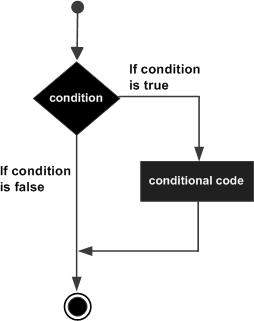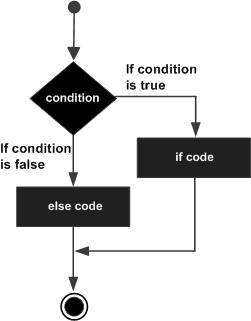![]() Предыдущая часть – операторы.
Предыдущая часть – операторы.
В управляющих конструкциях разработчик указывает одно или больше условий, которые будут проверены программой во время выполнения, и в зависимости от этих условий – будут выполнены операторы, если уловие было истинно, и опционально – операторы, которые будут выполненын, если условие было false.
Базовая управляющая конструкция сходна во всех языках программирования, и выглядит так:
В Go поддерживаются следующие операторы:
| Sr.No | Statement & Description |
|---|---|
| 1 | if statementоператор if состоит из будева выражения, за которым следуют одно или более других операторов или выражений для выполнения |
| 2 | if…else statementза оператором if может следовать else, код после которого выполняется, если предыдущее выражение было false |
| 3 | nested if statementsтак же допустимо использование вложенных конструкций if/else if внутри других if/else if |
| 4 | switch statementоператор switch используетс ядля проверки значения переменной на соответсвие списку допустимых значений |
| 5 | select statementоператор slect схож со switch, но используется преимущественно с каналами |
Содержание
Оператор IF
Синтаксис:
if(boolean_expression) {
/* statement(s) will execute if the boolean expression is true */
}
Если boolean_expression будет true, тогда будет выполнен блок внутри оператора if, заключённй в {}.
Если выражение будет false – то будет выполнен код, следующий раз за закрывающей фигурной скобкой.
Пример:
package main
import "fmt"
func main() {
/* local variable definition */
var a int = 10
/* check the boolean condition using if statement */
if( a < 20 ) {
/* if condition is true then print the following */
fmt.Printf("a is less than 20\n" )
}
fmt.Printf("value of a is : %d\n", a)
}
Результат:
[simterm]
$ go run if.go a is less than 20 value of a is : 10
[/simterm]
Оператор IF/ELSE
За оператором if может следовать оператор else, код в котором будет выполнен, если выражение было false.
Синтаксис:
if(boolean_expression) {
/* statement(s) will execute if the boolean expression is true */
} else {
/* statement(s) will execute if the boolean expression is false */
}
Пример:
package main
import "fmt"
func main() {
/* local variable definition */
var a int = 100;
/* check the boolean condition */
if( a < 20 ) {
/* if condition is true then print the following */
fmt.Printf("a is less than 20\n" );
} else {
/* if condition is false then print the following */
fmt.Printf("a is not less than 20\n" );
}
fmt.Printf("value of a is : %d\n", a);
}
Результат:
[simterm]
$ go run if_else.go a is not less than 20 value of a is : 100
[/simterm]
ELSE IF оператор
Опционально, за if может следовать оператор else if, за которым может быть завершающий else, что удобно для проверки нескольких условий.
Помните, что оператор if может иметь ноль или только один оператор else, который должен быть заключающим в цепочке else if. При этом if может иметь любое колчиество операторов else if, но все они должны предшествовать заключающему else.
Как только любое из уловий в else if будет успешным – все остальные будут проигнорированы.
Синтаксис:
if(boolean_expression 1) {
/* Executes when the boolean expression 1 is true */
} else if( boolean_expression 2) {
/* Executes when the boolean expression 2 is true */
} else if( boolean_expression 3) {
/* Executes when the boolean expression 3 is true */
} else {
/* executes when the none of the above condition is true */
}
Пример:
package main
import "fmt"
func main() {
/* local variable definition */
var a int = 100
/* check the boolean condition */
if( a == 10 ) {
/* if condition is true then print the following */
fmt.Printf("Value of a is 10\n" )
} else if( a == 20 ) {
/* if else if condition is true */
fmt.Printf("Value of a is 20\n" )
} else if( a == 30 ) {
/* if else if condition is true */
fmt.Printf("Value of a is 30\n" )
} else {
/* if none of the conditions is true */
fmt.Printf("None of the values is matching\n" )
}
fmt.Printf("Exact value of a is: %d\n", a )
}
Результат:
[simterm]
$ go run else_if.go None of the values is matching Exact value of a is: 100
[/simterm]
Вложенный IF
Так же допустимо использование вложенных конструкций if/else, т.е. указание одного блока условий внутри другого.
Синтаксис:
if( boolean_expression 1) {
/* Executes when the boolean expression 1 is true */
if(boolean_expression 2) {
/* Executes when the boolean expression 2 is true */
}
}
Пример:
package main
import "fmt"
func main() {
/* local variable definition */
var a int = 100
var b int = 200
/* check the boolean condition */
if( a == 100 ) {
/* if condition is true then check the following */
if( b == 200 ) {
/* if condition is true then print the following */
fmt.Printf("Value of a is 100 and b is 200\n" );
}
}
fmt.Printf("Exact value of a is : %d\n", a );
fmt.Printf("Exact value of b is : %d\n", b );
}
Результат:
[simterm]
$ go run if_nested.go Value of a is 100 and b is 200 Exact value of a is : 100 Exact value of b is : 200
[/simterm]
Оператор switch
Оператор switch позволяет выполнять проверку значения переменной на равенство заданному значению, которое называется case.
Переменная проверяется по списку таких case, и в случае, если значение переменной равно значению в case – выполняется следующий за case код.
В Go switch может быть двух типов:
- Expression Switch – в
caseсодержится некоторое выражение, результат которого сравнивается со значением выражения вswitch - Type Switch – в
caseсодержится тип, который сравнивается с типом в выраженииswitch
Expression Switch
Синтаксис:
switch(boolean-expression or integral type){
case boolean-expression or integral type :
statement(s);
case boolean-expression or integral type :
statement(s);
/* you can have any number of case statements */
default : /* Optional */
statement(s);
}
Пример:
package main
import (
"fmt"
"os"
"strconv"
)
func main() {
var grade string
// assign first argument to masrks variable
marks, _ := strconv.Atoi(os.Args[1])
switch marks {
case 90: grade = "A"
case 80: grade = "B"
case 50,60,70 : grade = "C"
default: grade = "D"
}
switch {
case grade == "A" :
fmt.Printf("Excellent!\n" )
case grade == "B", grade == "C" :
fmt.Printf("Well done\n" )
case grade == "D" :
fmt.Printf("You passed\n" )
case grade == "F":
fmt.Printf("Better try again\n" )
default:
fmt.Printf("Invalid grade\n" );
}
fmt.Printf("Your grade is %s\n", grade );
}
Результат:
[simterm]
$ go run expr_switch.go 90 Excellent! Your grade is A
[/simterm]
И если передать 50:
[simterm]
$ go run expr_switch.go 50 Well done Your grade is C
[/simterm]
Type Switch
Синтаксис:
switch x.(type){
case type:
statement(s);
case type:
statement(s);
/* you can have any number of case statements */
default: /* Optional */
statement(s);
}
Для type switch – выражение в switch должно иметь переменную типа interface{}.
Пример:
package main
import "fmt"
import "os"
func main() {
var x interface{}
if (len(os.Args) >= 2) {
x = os.Args[1]
}
switch i := x.(type) {
case nil:
fmt.Printf("type of x: %T\n", i)
case int:
fmt.Println("x is int")
case float64:
fmt.Println("x is float64")
case func(int) float64:
fmt.Printf("x is func(int)")
case bool, string:
fmt.Println("x is bool or string")
default:
fmt.Println("don't know the type")
}
}
Результат с передачей string:
[simterm]
$ go run type_switch.go str x is bool or string
[/simterm]
И пустого аргумента:
[simterm]
$ go run type_switch.go type of x: <nil>
[/simterm]
Оператор Select
Синтаксис:
select {
case communication clause :
statement(s);
case communication clause :
statement(s);
/* you can have any number of case statements */
default : /* Optional */
statement(s);
}
Тип для оператора case при использовании select должен быть операцией передачи данных в канал (channel рассмаривается далее).
Пример:
package main
import "fmt"
func main() {
var c1, c2, c3 chan int
var i1, i2 int
select {
case i1 = <-c1:
fmt.Printf("received ", i1, " from c1\n")
case c2 <- i2:
fmt.Printf("sent ", i2, " to c2\n")
case i3, ok := (<-c3): // same as: i3, ok := <-c3
if ok {
fmt.Printf("received ", i3, " from c3\n")
} else {
fmt.Printf("c3 is closed\n")
}
default:
fmt.Printf("no communication\n")
}
}
Результат:
[simterm]
$ go run select.go no communication
[/simterm]
Продолжение – часть 8 – циклы.









 5 835 views
5 835 views